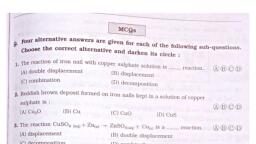Question 1 :
An oxidizing agent is always takes part in the reduction process while a reducing agent is always take part in the _______ process.
Question 2 :
State true or false.<br/><br/>In redox reactions, oxidation and reduction take place simultaneously.<br/>
Question 3 :
Which of the following reaction requires oxygen to be a reactant ?
Question 4 :
$KXO_3$(s) well mixed with water, temperature of solution falls. This reaction is:<br/>
Question 8 :
In $HS^, I^, R-NH_2, NH_3$ order of proton excepting tendency will be:
Question 9 :
AB + CD $\rightarrow$ AD + BC<br/><br/>The reaction is an example of _________.<br/><br/><br/>
Question 12 :
When chlorine reacts with sodium bromide the solution turns brown because ________.
Question 14 :
<p>Oils on treating with hydrogen in the presence of palladium or nickel catalyst form fats. This is an example of :</p>
Question 15 :
The conversion of ${Cr}_{2}{O}_{7}^{2-}$ to ${Cr}^{3+}$ during a chemical reaction is an example of:
Question 16 :
Balanced chemical equations imply which of the following?<br>$I$. Numbers of molecules are conserved in chemical change<br>$II$. Numbers of atoms are conserved in chemical change.<br>$III$. Mass is conserved in chemical change.
Question 17 :
Identify the type of reaction which will occur based on the information provided about the reactants:<br>${CH}_{4}(g)+{O}_{2}(g)\rightarrow$
Question 18 :
Which type of chemical decomposition reaction is the following reaction?<br>$Cu(OH)_2\xrightarrow {heat} CuO+H_2O$
Question 20 :
$FeCl_3 + 3NaOH \rightarrow 3NaCl + Fe(OH)_3$<br/><br/>The reaction is an example of________.
Question 21 :
Aqueous solutions of magnesium chloride and silver nitrate are mixed to form solid silver chloride and aqueous magnesium nitrate.<br/><br/>The balanced molecular equation contains which one of the following terms?
Question 25 :
Which of the following symbol is used to show solid precipitate?
Question 27 :
Three cations $A, B, C$ are allowed to react with ammonium hydroxide solution. $A$ and $B$ produce a dirty green precipitate and a reddish brown precipitate respectively, both of which do not dissolve on further addition of ${NH}_{4}OH$. $C$ gives pale blue colour precipitate with less amount of ammonium hydroxide and on further addition of ${NH}_{4}OH$, precipitate becomes soluble and deep blue colour solution is formed:
Question 28 :
In the reaction, $4Fe+3O_2\rightleftharpoons 4Fe^{3+}+6O^{2-}$ Which of the following statements is incorrect?
Question 30 :
The reaction of hydrochloric acid with zinc oxide to form zinc chloride and water is neutralization reaction. State whether the statement is true or false
Question 31 :
A less reactive metal replaces a more reactive metal from its salt solution in water.<br>
Question 32 :
The substance that initially involved in a chemical reaction is called a reactant.
Question 34 :
What is the difference between displacement over double displacement reactions ?
Question 36 :
Other signs of a chemical reaction might be an increase in temperature if heat is released or a change in _____.
Question 38 :
A chemical reaction in which heat is evolved is called a/an:<br/>
Question 40 :
Which of the following is an example of the exothermic reaction ?
Question 42 :
Name the type of the following chemical reaction.$2KClO_3 \rightarrow 2KCl +3O_2$
Question 44 :
State true or false.<br/>In a chemical equation, the products are written on the left-hand side and the reactants on the right-hand side with an arrow in between.
Question 46 :
Reaction of iron nails with copper sulphate solution is an example of ____________.
Question 47 :
Which of the following is(are) an endothermic process(es) ?<br>(i) Dilution of sulphuric acid<br>(ii) Sublimation of dry ice<br>(iii) Condensation of water vapours<br>(iv) Evaporation of water<br>
Question 48 :
Select the correct alternative.Which of the following is a decomposition reaction?
Question 50 :
Given $4NH_3(g)+5O_2(g)\rightarrow 4NO(g)+6H_2O(g)$<br>The above reaction is an example of:<br>(i)displacement reaction<br>(ii) combination reaction<br>(iii) redox reaction<br>(iv)neutralisation reaction


























